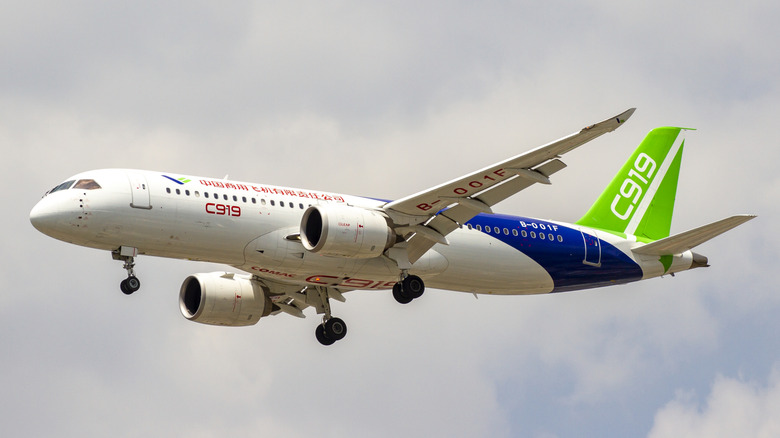Why China's C919 Airliner Can't Make International Flights (Yet)
For the past few decades, there have been two major players in the commercial aircraft sector — Boeing and Airbus. Now, there is a rising challenger looking to break the stranglehold of the dominant American and European giants. The Commercial Aircraft Corporation of China (COMAC) has designed and built its narrow-bodied C919 model to directly compete with the Airbus A320 and Boeing 737 families. China's COMAC C919 entered service in 2023 and is currently being used on internal Chinese routes and on flights to the Chinese Special Administrative Region of Hong Kong. However, right now, the C919 is confined to internal flights and Hong Kong, although the latter is technically considered an international flight.
Border technicalities aside, the C919 is currently restricted to flying within Chinese airspace. This delay in reaching international markets is largely due to certification issues. In the case of Europe, according to the European Union Aviation Safety Agency (EASA), this is expected to take between three and six years. The case is different when considering when we can expect to see the plane in US skies; currently, COMAC is not looking to gain certification from the Federal Aviation Administration (FAA). Although, the International Civil Aviation Organization list has 193 member states, and COMAC is actively seeking certification from several of these regulatory bodies. Let's have a closer look at the plane that could yet give the big two of commercial aviation a run for their money.
C919 - A new player in the narrow-body market
The C919 has been a long time in the making. The project was first announced by COMAC in 2009, with the initial expectation that the plane would begin rolling out to airlines by 2016. However, the maiden flight of the aircraft didn't happen until May 2017. The first commercial flight had to wait until May 2023 when the launch customer — China Eastern Airlines — flew the plane on its Shanghai to Beijing route. The two-hour flight landed at Beijing Capital Airport and was greeted with a water salute upon arrival.
Since then, the aircraft has carried over two million passengers, and China Eastern Airlines now has 18 C919s in service. In total, as of January 2025, there were believed to be about 16 C919s in service, with Chinese airlines and another 27 set to be delivered throughout the year. The company has also announced a five-year plan to ramp up production numbers to 150 aircraft per year.
For comparison, Airbus production of its comparative Airbus A320 model is estimated to be about 50 a month, with the company aiming to increase this to 75 per month by 2027. Currently, Boeing is restricted to building 38 737s per month, it's hoped this can be raised to 42 per month sometime this year. In either case, these figures are substantially more than the current expectations for the C919.
COMAC C919 - Some technical stuff
The Chinese C919 was developed to try and break into the narrow-bodied market, but also to reduce China's reliance on foreign technologies. Despite this, the aircraft still uses western-built components and systems. Starting with the engines, although there is apparent progress in designing a home-grown engine for the C919, the plane currently uses CFM International LEAP-1C engines. CFM is a partnership between Safran and General Electric, and the LEAP family of engines is a major part of GE's jet engine range. Variations of these engines also power the Boeing 737 and the Airbus A320. The plane's avionics is another area where there is a definite Western tinge. These are supplied by Aviage Systems, which is another 50/50 partnership that features GE. However, this time the partnership is with AVIC, a Chinese state-owned aerospace firm.
While it might not fly in international skies as it stands, the C919 could yet rise to the challenge and upset the old order. COMAC can perhaps take some solace from Airbus's early problems with getting established. From the time its first plane took to the skies on October 28, 1972, it took until 1977 when the first order from the US was negotiated. And the four jets involved were loaned to Eastern Air Lines at no cost in order to generate interest. From these humble beginnings, Airbus has grown to become an aviation behemoth. Only time will tell if the C919 can follow the same path.

